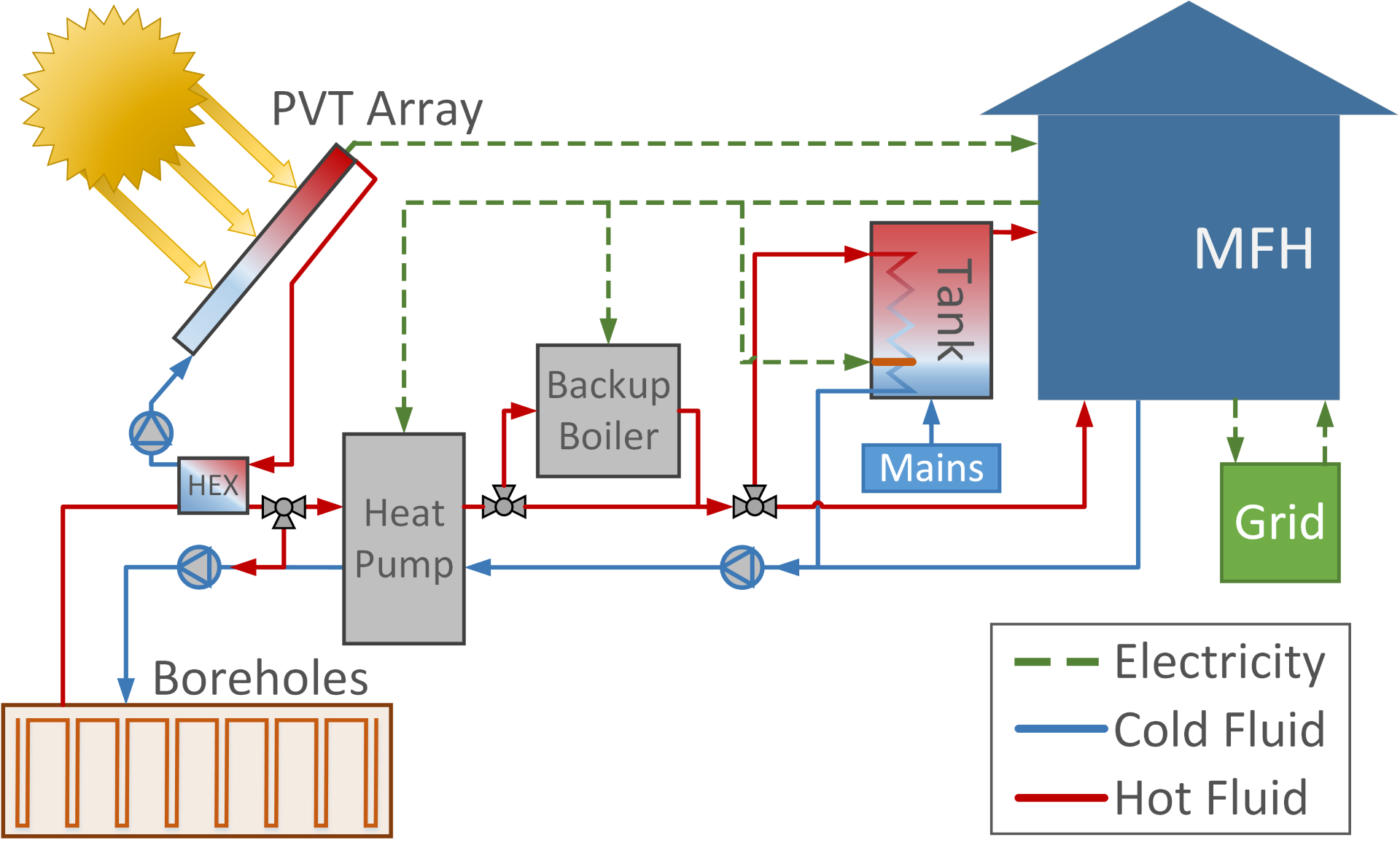Smart Solar Hybrid Solutions for Sustainable European Buildings (completed)
Achieving the ambitious national goals in the Swedish building sector are impossible without smart, cost-effective, scalable, and integrated solutions for heating, cooling and electricity. The goal of this project is to advance the development of an integrated heating, cooling and electricity system solution for European buildings using solar PVT technology and ground source heat pumps.

Funded by: Mistra Innovation
Time period: January 2020 – December 2023
Project partners:
KTH Energy Technology
Solhybrid i Småland AB
Bengt Dahlgren Stockholm Geo A
MegaWatt Solutions Nordic AB
Background
The combination of solar PV/thermal collectors and ground source heat pumps are a scalable sustainable energy alternative for not only Swedish Multi-family houses and micro-districts, but also other European residential districts.
A promising pathway to the electrification and decarbonization of buildings are solar heat pumps (SHP). There a numerous methods for combining the two technologies, however, one increasingly interesting approach is the integration of photovoltaic/thermal hybrid collectors (PVT) with ground source heat pumps (GSHP). The benefits from this approach are:
- dramatic reduction of the amount of land needed for boreholes in new systems,
- recovery of degraded boreholes without the need for additional drilling,
- high thermal production from PVT due to the low temperatures in a borehole circuit,
- seasonal storage of solar heat from summer to winter,
- greater electricity production from PV also due to the low temperatures, and
- lower costs than traditional solar thermal designs.
Recent cost reductions have dramatically increased the solar PV market in Sweden, but PVT collectors have virtually no market share in comparison in part because the PVT+GSHP concept is at a very early stage of commercialization. This project is motivated by the potential for smart solar hybrid concepts to scale and decarbonize the building sector in Sweden and Europe. Its foundation stems primarily from two previously completed projects – the small Mistra Innovation project “Sunhybrid” (number MI15.18) led by Solhybrid i Småland and the Effsys Expand research project “Ground Source Heat Pumps for Swedish Multi-Family Houses: Innovative Co-Generation and Thermal Storage Strategies[A1]” (number 40936-1) led by KTH.
Aim and Objectives
The overall objective of this project is to advance in the development of an integrated heating, cooling, and electricity system solution for European buildings using solar PVT technology and ground source heat pumps. The project focuses on component, system, and business development and optimization.
The project aims at investigating the methods and strategies to reduce both operational and capital cost of the system as well as increasing the system efficiency. A system pilot will be constructed and monitored with sustainable business models developed for diverse applications in domestic and export markets.
At a component level, the goal is to further develop a PVT module specifically for heat pump integration that improves thermal efficiency while reducing production costs. At a system level, the goal is to validate and optimize the PVT heat pump concept in an expanded range of applications and markets. At a business level, the project aims to create the necessary business models for deploying PVT collectors and PVT heat pump systems considering supply chains, component certification, systems integration, and installer qualifications.
Outcomes
The first part of the project focused on identifying and modeling novel PVT collector designs that increase surface area contact between the working fluid, PV module, and air using computational fluid dynamics, to identify optimal flow distribution patterns and heat flux potential. The influence of materials (i.e. metals vs polymers) on heat transfer was also tested with special consideration for manufacturing techniques and cost-effectiveness. From a techno-economic perspective, it arises that the optimal design is a function of the system's goals. An aluminum corrugated or box channel design with 20 or 30-mm fins is recommended to maximize thermal output. Conversely, to maximize energy per cost of material, a corrugated polycarbonate design without fins or forced convection proves to be the best alternative due to a 50% higher energy-to-cost ratio, despite a potentially lower thermal energy yield compared to its metallic counterparts.
The second part of the project included testing and benchmarking of different commercially available PVT collectors to identify optimal design features for ground source heat pump integration, alongside assessing a PVT collector prototype. The tests were conducted at a newly built outdoor testing facility at KTH, to validate the main findings from the numerical modeling work and inform new PVT models for systems simulation. The results show that a box-channel aluminum design with 20 mm fins is recommended for integration with ground source heat pump systems. It has a high annual thermal energy output and does so with good material efficiency at a thermal unit cost that is marginally higher than a reference sheet and tube PVT.

The final part of the project consisted of applying the different PVT collector designs in holistic optimizations. The simulations, made in TRNSYS, were dynamic and included all components in the system. Of the considered designs, the Box-channel Aluminum collector with 20 mm fins (BC-AL-20) is the recommended one when it comes to series/regenerative integration with ground source heat pumps, which confirms the conclusions of the first two parts of the project. On the technical aspect, it combines a high zero-loss efficiency, which allows it to capture more of the incoming solar irradiation, with a high U-value, that enhances heat capture from the air during times of low solar irradiation. On the economic aspect, it is on par with the sheet and tube (S&T) design with the lowest TLCC. It is also found that PVT collectors have a much higher potential in systems with degraded or undersized borehole fields than in new systems with a properly sized borehole field.

Academic Publications
Journal Articles
Beltrán, F., Sommerfeldt, N., Reichl, C., Madani, H. 2023. Techno-economic analysis of photovoltaic/thermal collector designs for integration with ground source heat pump systems. Under review at Solar Energy, 2023
Conference Articles
Master Theses
